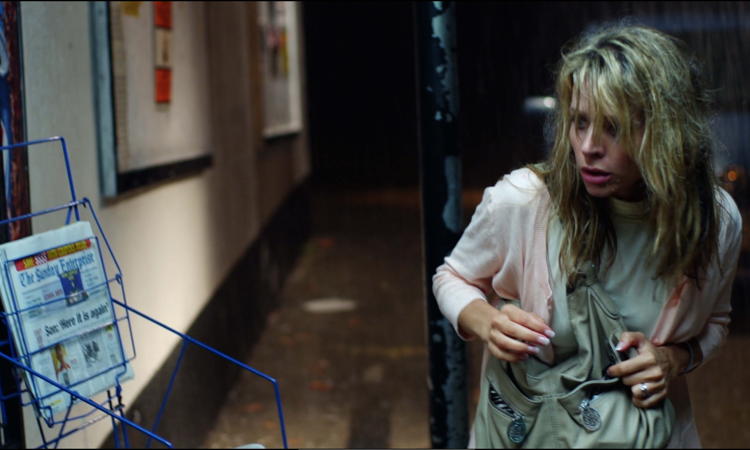Sign up for the
TSL Newsletter
and get $50 off Final Draft 12
By Nguyen Le · January 27, 2014

How ironic that misery can be the key to happiness. Lester Burnham (Kevin Spacey) found it in American Beauty and now Anna Thompson (Jessalyn Gilsig – Terri Schuester from Glee) from Somewhere Slow will too. Neat, touching and honest – these are qualities applicable to Jeremy O’ Keefe’s dramedy about life and how to live it.
After the title comes up, one thing is made very clear: Anna is in crisis. Working for a cosmetics company, she maintains her appearance via heavy make-up and consuming-then-regurgitating meals. Said company later fire her for not working as well as another employee. After that, it’s “Mr. Thompson’s (David Costabile – Gale Boetticher in Breaking Bad) day” as opposed to a proper wedding anniversary. Then, Anna finds out her mother Katherine (Lindsay Crouse – Sharon Tiller from The Insider) is dying of cancer and her sister Julie (Lauren Schneider – Karen in Creature) is not pleased at being the only daughter who is aware of things. Moments later, Anna’s car dies and so does her phone, the robber, plus the clerk of the convenience store who just sold her a pack of cigarettes. A botched robbery, surprisingly, serves as the major turning point for our character and her depressing life.
Then, Anna meets Danny (Graham Patrick Martin – Rusty Beck in Major Crimes), a carefree and straightforward teen who has his own issues. Like Anna, Danny is running away to make a fresh start in life. However, he is all about “be who you are” when Anna is constantly in need of a shell. Despite the difference in perspective and age, both start a relationship and a journey of self-discovery. Will this romance work? Or will the things they are not telling to one another affect them in the end?
And what a delivery! Here we have two compelling performances from Gilsig and Martin, although I admit in the beginning I was worried about Gilsig because her portrayal of Anna’s phoniness is quite over-the-top, a word I have often seen associated to Annette Bening’s performance (which Anna heavily reminds me of) in American Beauty. Yet thankfully, Gilsig seems to be in control the whole way through, effectively displaying the changes her character experiences – from someone with a face more powder than skin, ambiguous smiles and flashy attire to a person much softer, casual and simple in nature. The converting process works due to Martin who brings tangible sexual tension in his looks towards or the amount of energy in how he speaks with Gilsig’s character. Both are really expressive but director O’ Keefe never lets them go overboard with emotions and for that the many layers of Anna and Danny become apparent. One notable sequence is when our characters arrive at the cottage where you will get to see Danny’s soothing effect on Anna through the tone of Martin’s voice and the way Gilsig gently changes her performance to reflect Anna’s calmer state of mind. There are traps everywhere to go overly sentimental here but instead O’ Keefe has made the moment very real.
The realness manifests itself in the script written by O’ Keefe too. Humorous lines do conjure laughs, e.g. coffee gets linked with celebrities and the “breakfast burrito”. Adding to that, characters say plausible things that make them relatable, i.e. at one point Anna does feel “wrong” about her love with Danny. As a viewer, I know Danny brings happiness to Anna at her hour of need but to have (and hear) her questioning the action makes me more aware of its significance. The same can be said for moments when Danny persuades Anna to stop making a shell to hide inside. Instead of being dramatic, everything feels natural.
From a technical standpoint, the film can be crude at times. An important sequence has these odd brief pre-dialogue pauses when cut to another angle, certain camera placements give the film a very pedestrian look and parts where you wish the music should have not come up at all. Nevertheless, sparks of genius do appear now and then. There are a couple of night shots and a beautiful “romance-by-the-setting-sun” sequence that cinematographer Justin Talley might have learn from the late great Harris Savides (The Bling Ring), brilliant sequences of intercuts and music choices that help amplifying the corresponding on-screen emotions. In a way, though, the crudeness is also Somewhere Slow’s blessing for it adds more to the film’s theme of being true.
Somewhere Slow at times is like the “light” version of American Beauty but such comparison is unfair for the former does not try to be the latter. So, to get back on point, Jeremy O’ Keefe’s second film is highly watchable for its subtle characterization, great performances, tight and meaningful narrative despite the raw aesthetics.